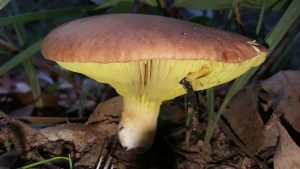#046: Mushroom Morphology: False Truffles
False truffles are basidiomycetes that produce fruiting bodies at or below the soil surface (hypogeous). These mushrooms are included in the gasteromycetes because they develop their spores internally and have lost the ability to forcibly discharge their spores. Like the true truffles, false truffles disperse their spores by attracting animals like insects, rodents, and deer. False truffles secrete scents to attract these animals, which eat the mushrooms and spread the spores around in their feces. Most false truffles have a gleba (the internal, spore-producing tissue) that is divided up into small chambers called locules. Many false truffles also have a short stipe at the base or a stipe-columella that extends into the gleba as a branching structure. Aside from the stipe-columella, the gleba of false truffles is fairly regular in appearance. This easily separates them from true truffles, which appear marbled when sliced in half.







![#011: Characteristics of Kingdom Fungi [Archived]](https://www.fungusfactfriday.com/wp-content/themes/hueman/assets/front/img/thumb-small-empty.png)

